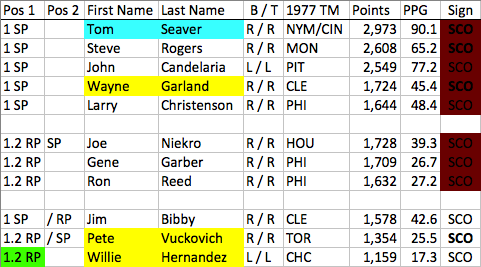1977 Fantasy Astrology Recap
View the 1977 FABL Lineups Here!
Last time, I remarked that 1978 would probably be the last reverse-chronological season in a while, as I focus my attention on the player movement extravaganza involved in constructing the rosters to go with the uniforms I already made. But it turns out I had the bandwidth for one more year, as I wait for just one more roster update to come out (the next one drops on Friday). And it also turns out that 1977 serves as a much better stopping point, as it marks an important expansion milestone.
1977 was the inaugural year of the Toronto Blue Jays and the Seattle Mariners, whose introductions marked the end of the Expansion Era. No new teams would debut until 1993, when the Marlins and Rockies once again evened the number of teams in the leagues. Of course, speaking reverse-chronologically, 1977 is the last time when we’ll have 26 teams from which to pull Fantasy Astrology players. And since pickings are already pretty slim for some positions on some signs, we might have to get creative as we fill out these earlier lineups.
One sign that didn’t have slim pickings at any position was Scorpio, who would repeat as top point scorer the following (actual chronological) year. The Stingers (technically Scorpions) had a trio of stars on both sides of the ball. Traded Negative Polarity Cy Young Award winner Tom Seaver (2,973 / 90.1 – from the Mets to the Reds) led the pitching rotation, along with Steve Rogers (2,608 / 65.2) and John Candelaria (2,549 / 77.2). The outfield consisted of NL East leading Phillies slugger Greg Luzinski (2,527 / 17.0) and two qualified center fielders: Lyman Bostock (2,300 / 15.0) of the Twins and Al Cowens (2,382 / 14.7) of the AL West champion Royals. Their bullpen is questionable, as top primary reliever Joe Niekro (1,728 / 39.3) started 14 of his 44 appearances… but they comfortably lead the league even without the swingman’s production factored in.
Libra first baseman Rod Carew (2,835 / 18.3) was the second fantasy-scoring batter in the game, losing Positive Polarity MVP award to Sagittarius outfielder George Foster (3,003 / 19.0). Carew led a Scales offense alongside third base tandem Mike Schmidt and Enos Cabell, and PP Rookie of the Year sensation Mitchell Page (2,292 / 15.8). PP CYA winner Jim Palmer (2,959 / 75.9) and pre-relief Dennis Eckersley (2,198 / 66.6) do enough work to overshadow a bullpen almost completely bereft of high impact arms. I should note that in my official points tally, I moved Carew to his secondary position of second base (where he hadn’t played regularly since 1975) to make room for Keith Hernandez (1,977 / 12.3) at first base. But even with Carew back at first and light-hitting Jerry Royster (1,028 / 7.3) at the keystone, Libra still scored the most points in the 1977 Air Division.
I made a pair of similar judgment calls with Fire Division leader Aries – which similarly had no effect on the divisional points-race. With Reggie Smith (2,303 / 15.6) cemented in right field, I completed the outfield with Ken Griffey (Sr.) (2,089 / 13.6) in center field and Rusty Staub (2,005 / 12.7) in left. The problem is, Griffey wouldn’t play his first major league game in center until the following year, and Staub was a dedicated designated hitter until 1979. This configuration is reasonable to consider, considering that Griffey would log over 200 career games as a center fielder, and Staub would still have holdover outfield eligibility from the previous season. And it would allow a 1B/DH pairing of Bob Watson (2,073 / 13.7) and George Scott (2,087 / 13.3) to join hit king Pete Rose (2,055 / 12.7) who’s at third base.
We do have a disputed winner of the Earth Division between Taurus and Capricorn. Each sign had a 2,900-point starting pitcher: Dennis Leonard (2,957 / 77.8) for TAU and Steve Carlton (2,957 / 82.2) for CAP. The Bulls had three different 16-point-per-game batters: third baseman George Brett (2,298 / 16.5), center field eligible Larry Hisle (2,366 / 16.8), and right fielder Reggie Jackson (2,333 / 16.0) in the season that earned him the moniker Mr. October. PPG for Goats batters topped out in the 14 range: catcher Carlton Fisk (2,248 / 14.8) and first baseman Steve Garvey (2,274 / 16.1) (whose Dodgers lost to Jackson and the Yanks in the Fall Classic), but Capricorn also had a shut-down closer in Bruce Sutter (2,472 / 39.9) to pick up the slack - although he finished behind Cancer Crab Rich “Goose” Gossage (2,548 / 35.4) for NP Reliable Reliever honors.
The changes that led to a swap of divisional leaders all come from Taurus, as Capricorn’s point total basically stays the same when positional eligibility rules are followed to the letter? The flashiest choice I made was to put Phil Garner (2,112 / 13.8) at shortstop, despite his only having 12 games there all season. But the bigger issue is the lack of Bulls bullpen depth (ironically enough, considering the similarities of the words). Yankees setup man Dick Tidrow (1,484 / 30.3) had the top season, despite starting 7 of 49 games, while rookie Dennis Martinez (1,391 / 33.1) had a more egregious 13 starts out of 42. But the game was played differently back then, and I feel like it’s wrong to disqualify a pitcher from relief status just because they started a handful of games. In fact, if you replace Garner with actual shortstop Rick Burleson (1,598 / 10.4), leave Tidrow, but remove Martinez, Taurus still comes out on top!




